应用语言学与英语教学
- 格式:doc
- 大小:40.00 KB
- 文档页数:4
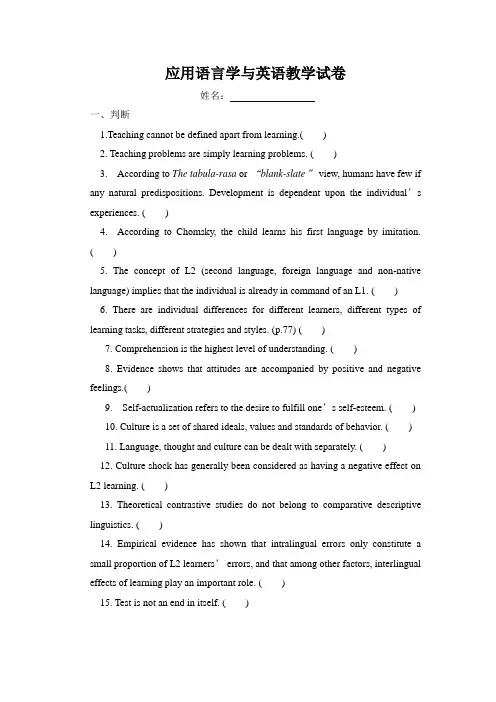
应用语言学与英语教学试卷姓名:一、判断1.Teaching cannot be defined apart from learning.( )2. Teaching problems are simply learning problems. ( )3. According to The tabula-rasa or“blank-slate”view, humans have few if any natural predispositions. Development is dependent upon the individual’s experiences. ( )4. According to Chomsky, the child learns his first language by imitation. ( )5. The concept of L2 (second language, foreign language and non-native language) implies that the individual is already in command of an L1. ( )6. There are individual differences for different learners, different types of learning tasks, different strategies and styles. (p.77) ( )7. Comprehension is the highest level of understanding. ( )8. Evidence shows that attitudes are accompanied by positive and negative feelings.( )9. Self-actualization refers to the desire to fulfill one’s self-esteem. ( )10. Culture is a set of shared ideals, values and standards of behavior. ( )11. Language, thought and culture can be dealt with separately. ( )12. Culture shock has generally been considered as having a negative effect on L2 learning. ( )13. Theoretical contrastive studies do not belong to comparative descriptive linguistics. ( )14. Empirical evidence has shown that intralingual errors only constitute a small proportion of L2 learners’errors, and that among other factors, interlingual effects of learning play an important role. ( )15. Test is not an end in itself. ( )二、选择题1.The learner has an even greater role to play in the ______ process.A. teachingB. learningC. teaching-learning2. Learning is _____ dependent upon environment.A. completelyB. partlyC. unnecessarily3. According to Chomsky, the child learns his first language by______.A. imitationB. creative hypothesis-testingC. hypothesis-testing4. Attitude is generally agreed to show three aspects: ___ ___ and ___.A. cognitive, affective, behavioralB. mental, affective, behavioralC. mental, personal, cognitive5. According to Maslow, the high level needs of self-actualization are growth needs, whereas those below are ______.A. deficiency needsB. incomplete needsC. fundamental needs6. Haviland (1975) summarizes four universal characteristics of culture: Culture is shared, based on symbols, integrated, and ______.A. inheritedB. learnedC. developed7. Interlanguage refers to “the _____ meaningful performance”in a second language.A. limitedB. learnedC. attempted8. Errors made by L2 learners can be observed, analyzed, classified, and ______.A. expectedB. describedC. corrected9. Error analysis generally consists of three stages, namely, identification, _____ and explanation.A. correctionB. expectationC. description10. A good test must meet four requirements: _____, reliability, discrimination and practicality.A. validityB. responsibilityC. facility11. The TOEFL is a kind of ______.A. Aptitude testsB. Criterion-referenced testsC. Diagnostic tests12. According to Dulay et al. (1982), there are three kinds of motivation affecting language acquisition: Integrative motivation, _____ and Social-group-identification motivation.A. Instrumental motivationB. Practical motivationC. Creative motivation13. Stern (1983) identifies four basic sets of strategies from the basic considerations and research of language learning. These strategies are: Active planning strategy, Academic learning strategy, Social learning strategy, and _____ strategy.A. PracticalB. CreativeC. Affective14. As to how to correct errors, it requires a combination of _____, cognitive and linguistic judgment.A. objectiveB. subjectiveC. affective15. There are three methods to describe tests: central tendency, _______ and percentile rank.A. dispersion of scoresB. standard deviationC. variance答案:一、判断题1.T2. F3. T4. F5. T6. T7.F8.T9.F 10.T 11.F 12.T 13.F 14.F 15.T二、选择题1.C2. A3.B4. A5.A6. B7. C8. B9. C 10.A 11.B 12.A 13. C 14.C 15.A。
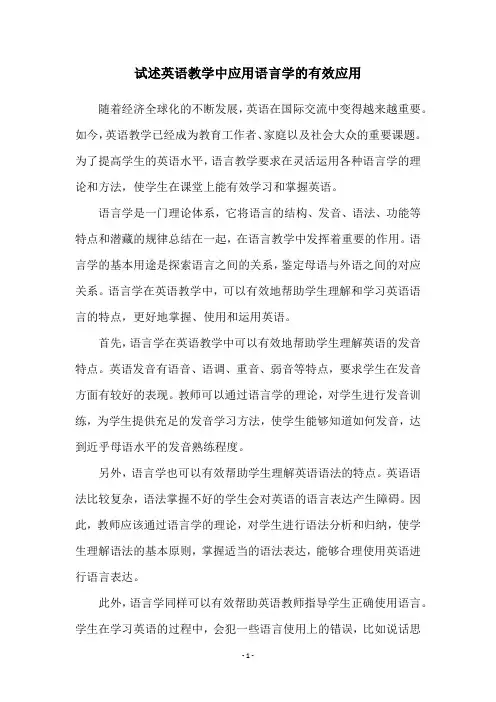
试述英语教学中应用语言学的有效应用随着经济全球化的不断发展,英语在国际交流中变得越来越重要。
如今,英语教学已经成为教育工作者、家庭以及社会大众的重要课题。
为了提高学生的英语水平,语言教学要求在灵活运用各种语言学的理论和方法,使学生在课堂上能有效学习和掌握英语。
语言学是一门理论体系,它将语言的结构、发音、语法、功能等特点和潜藏的规律总结在一起,在语言教学中发挥着重要的作用。
语言学的基本用途是探索语言之间的关系,鉴定母语与外语之间的对应关系。
语言学在英语教学中,可以有效地帮助学生理解和学习英语语言的特点,更好地掌握、使用和运用英语。
首先,语言学在英语教学中可以有效地帮助学生理解英语的发音特点。
英语发音有语音、语调、重音、弱音等特点,要求学生在发音方面有较好的表现。
教师可以通过语言学的理论,对学生进行发音训练,为学生提供充足的发音学习方法,使学生能够知道如何发音,达到近乎母语水平的发音熟练程度。
另外,语言学也可以有效帮助学生理解英语语法的特点。
英语语法比较复杂,语法掌握不好的学生会对英语的语言表达产生障碍。
因此,教师应该通过语言学的理论,对学生进行语法分析和归纳,使学生理解语法的基本原则,掌握适当的语法表达,能够合理使用英语进行语言表达。
此外,语言学同样可以有效帮助英语教师指导学生正确使用语言。
学生在学习英语的过程中,会犯一些语言使用上的错误,比如说话思想不清楚,句子构成不规范等。
语言教学应当开展相关的研究,从不同的角度探索语言的使用规则,帮助学生正确使用英语进行语言表达。
以上是语言学在英语教学中应用的几个重要方面。
在使用语言学的理论和方法进行英语教学时,应该根据学生不同的特点以及学习任务,定制合适的教学内容和方法。
教师在课堂上要灵活利用各种教学手段,例如语言学理论、课本解析、实际应用练习等,激发学生学习英语的兴趣,使之在短时间内达到有效学习的目的,为学生提供优质的英语教学服务。
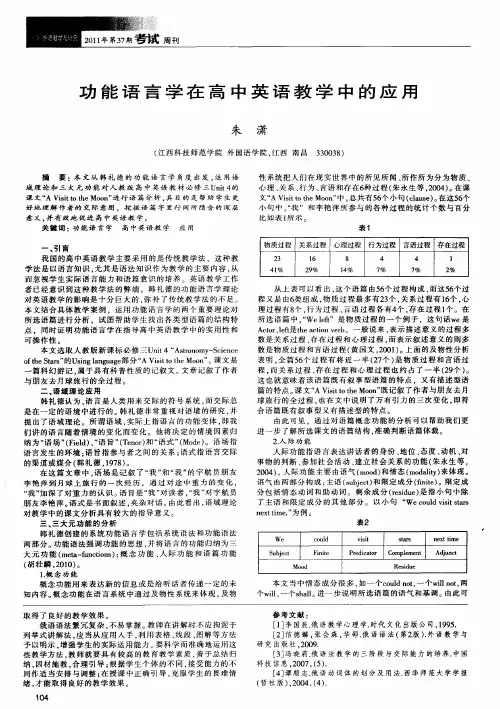
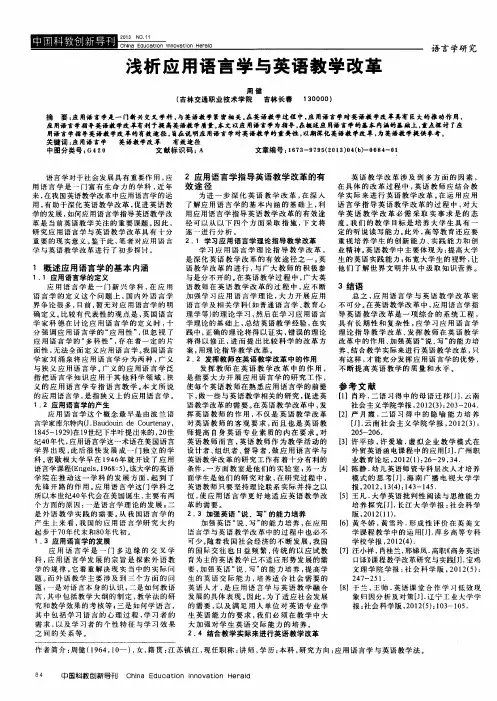

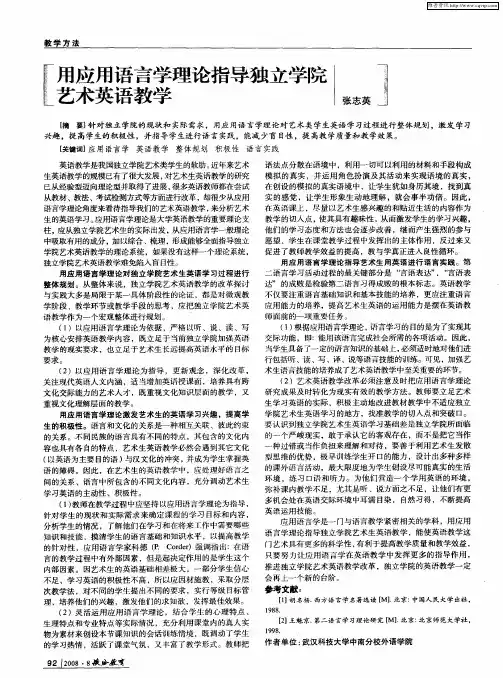

语言学理论在英语教学中的应用导言:随着全球化的推动,英语作为一门国际语言的地位日益重要。
对于母语非英语的学习者来说,学好英语是他们实现全球交流的关键。
而在这个过程中,语言学理论的应用在英语教学中起到了至关重要的作用。
本文将探讨语言学理论在英语教学中的应用,并就其中的几个重要理论进行阐述。
第一部分:社会交互理论的应用社会交互理论是语言学中的一种重要理论,它强调了在交际过程中的互动和共同构建意义的作用。
在英语教学中,运用社会交互理论可以激发学生学习英语的兴趣和积极性。
在课堂活动中,教师可以引导学生进行交互对话,让学生们在真实的语境中进行语言运用,从而提高他们的语言表达能力。
此外,教师还可以组织小组讨论或角色扮演等活动,让学生们积极参与其中,通过交互和合作的过程来增进他们的语言技能。
第二部分:认知语言学理论的应用认知语言学理论关注的是语言产生和理解的认知过程。
在英语教学中,运用认知语言学理论可以帮助学生更好地理解和运用语言。
例如,教师可以通过教授语法知识来帮助学生理解句子的结构和语法规则。
同时,教师还可以运用认知语言学理论中的“语言输入-语言输出”原则,鼓励学生进行大量的语言输出练习,通过实践不断提升他们的口语表达能力。
第三部分:交际语用理论的应用交际语用理论研究的是语言在交际过程中的使用规则和策略。
在英语教学中,运用交际语用理论可以帮助学生理解英语中的语用差异和社交礼仪,从而提高他们的跨文化交际能力。
例如,教师可以引导学生学习英语中的礼貌用语和表达方式,让他们了解在不同场合下应该如何使用语言。
此外,教师还可以通过讨论真实生活中的交际问题和情景模拟等活动,让学生们在实践中学习交际技巧。
第四部分:认知语言学习理论的应用认知语言学习理论研究的是语言学习的认知过程和策略。
在英语教学中,运用认知语言学习理论可以帮助学生更高效地学习英语。
例如,教师可以教授学生一些学习策略,如记忆单词的技巧、阅读理解中的积极推测等,帮助他们提高学习效果。
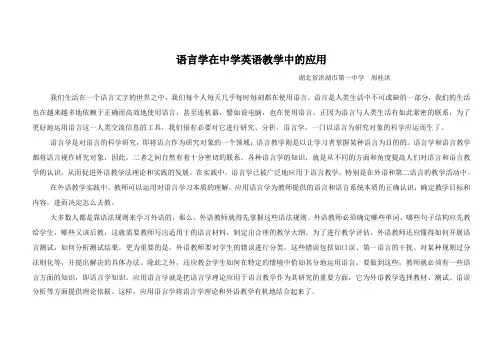
语言学在中学英语教学中的应用湖北省洪湖市第一中学周桂洪我们生活在一个语言文字的世界之中,我们每个人每天几乎每时每刻都在使用语言。
语言是人类生活中不可或缺的一部分,我们的生活也在越来越多地依赖于正确而高效地使用语言,甚至连机器,譬如说电脑,也在使用语言。
正因为语言与人类生活有如此紧密的联系,为了更好地运用语言这一人类交流信息的工具,我们很有必要对它进行研究、分析。
语言学,一门以语言为研究对象的科学应运而生了。
语言学是对语言的科学研究,即将语言作为研究对象的一个领域;语言教学则是以让学习者掌握某种语言为目的的。
语言学和语言教学都将语言视作研究对象,因此,二者之间自然有着十分密切的联系。
各种语言学的知识,就是从不同的方面和角度提高人们对语言和语言教学的认识,从而促进外语教学法理论和实践的发展。
在实践中,语言学已被广泛地应用于语言教学,特别是在外语和第二语言的教学活动中。
在外语教学实践中,教师可以运用对语言学习本质的理解,应用语言学为教师提供的语言和语言系统本质的正确认识,确定教学目标和内容,进而决定怎么去教。
大多数人都是靠语法规则来学习外语的,那么,外语教师就得先掌握这些语法规则。
外语教师必须确定哪些单词、哪些句子结构应先教给学生,哪些又该后教,这就需要教师写出适用于的语言材料,制定出合理的教学大纲。
为了进行教学评估,外语教师还应懂得如何开展语言测试,如何分析测试结果。
更为重要的是,外语教师要对学生的错误进行分类,这些错误包括如口误、第一语言的干扰、对某种规则过分法则化等,并提出解决的具体办法。
除此之外,还应教会学生如何在特定的情境中恰如其分地运用语言。
要做到这些,教师就必须有一些语言方面的知识,即语言学知识。
应用语言学就是把语言学理论应用于语言教学作为其研究的重要方面,它为外语教学选择教材、测试、语误分析等方面提供理论依据。
这样,应用语言学将语言学理论和外语教学有机地结合起来了。
普通语言学是研究人类语言的本质的功能,以及语言的产生和发展,它可以帮助人们认识和掌握外语教学的目的和一般规律。
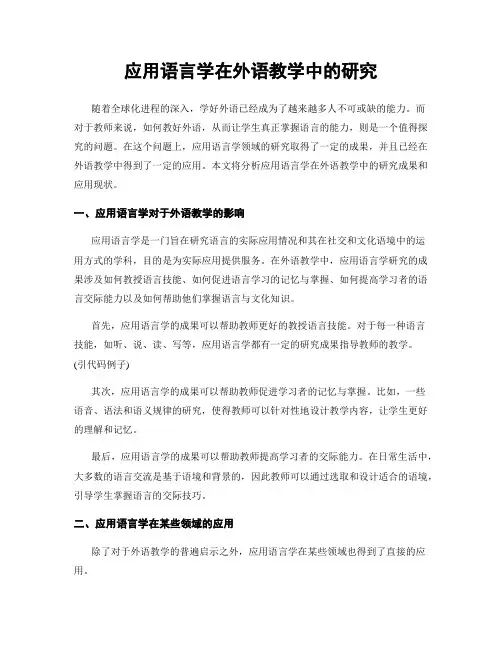
应用语言学在外语教学中的研究随着全球化进程的深入,学好外语已经成为了越来越多人不可或缺的能力。
而对于教师来说,如何教好外语,从而让学生真正掌握语言的能力,则是一个值得探究的问题。
在这个问题上,应用语言学领域的研究取得了一定的成果,并且已经在外语教学中得到了一定的应用。
本文将分析应用语言学在外语教学中的研究成果和应用现状。
一、应用语言学对于外语教学的影响应用语言学是一门旨在研究语言的实际应用情况和其在社交和文化语境中的运用方式的学科,目的是为实际应用提供服务。
在外语教学中,应用语言学研究的成果涉及如何教授语言技能、如何促进语言学习的记忆与掌握、如何提高学习者的语言交际能力以及如何帮助他们掌握语言与文化知识。
首先,应用语言学的成果可以帮助教师更好的教授语言技能。
对于每一种语言技能,如听、说、读、写等,应用语言学都有一定的研究成果指导教师的教学。
(引代码例子)其次,应用语言学的成果可以帮助教师促进学习者的记忆与掌握。
比如,一些语音、语法和语义规律的研究,使得教师可以针对性地设计教学内容,让学生更好的理解和记忆。
最后,应用语言学的成果可以帮助教师提高学习者的交际能力。
在日常生活中,大多数的语言交流是基于语境和背景的,因此教师可以通过选取和设计适合的语境,引导学生掌握语言的交际技巧。
二、应用语言学在某些领域的应用除了对于外语教学的普遍启示之外,应用语言学在某些领域也得到了直接的应用。
1. 多语种的课堂多语种的课堂环境是应用语言学在外语教学中的一种应用。
在多语种的课堂中,教师不仅要授课一种外语,还要考虑到学生母语和文化差异的因素,并将其融入教学内容中,通过语言对比及编档理论等方式,促进学生的语言和文化对比学习。
2. 语料库的利用语料库是应用语言学在外语教学中重要的工具之一。
教师可以通读大量语料库,获得语言的实际应用情况,比如最常用的语言表达方式、不同句型的使用频率等,从而根据学习者的实际需求和背景,选取最合适的语言材料,切实有效地提高学生成绩。
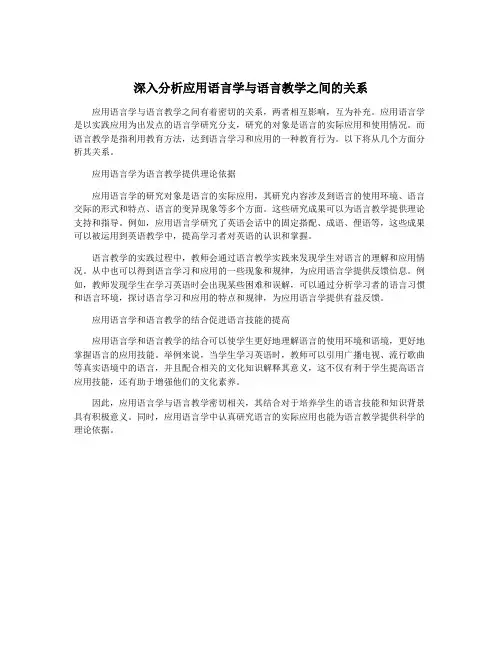
深入分析应用语言学与语言教学之间的关系
应用语言学与语言教学之间有着密切的关系,两者相互影响,互为补充。
应用语言学是以实践应用为出发点的语言学研究分支,研究的对象是语言的实际应用和使用情况。
而语言教学是指利用教育方法,达到语言学习和应用的一种教育行为。
以下将从几个方面分析其关系。
应用语言学为语言教学提供理论依据
应用语言学的研究对象是语言的实际应用,其研究内容涉及到语言的使用环境、语言交际的形式和特点、语言的变异现象等多个方面。
这些研究成果可以为语言教学提供理论支持和指导。
例如,应用语言学研究了英语会话中的固定搭配、成语、俚语等,这些成果可以被运用到英语教学中,提高学习者对英语的认识和掌握。
语言教学的实践过程中,教师会通过语言教学实践来发现学生对语言的理解和应用情况。
从中也可以得到语言学习和应用的一些现象和规律,为应用语言学提供反馈信息。
例如,教师发现学生在学习英语时会出现某些困难和误解,可以通过分析学习者的语言习惯和语言环境,探讨语言学习和应用的特点和规律,为应用语言学提供有益反馈。
应用语言学和语言教学的结合促进语言技能的提高
应用语言学和语言教学的结合可以使学生更好地理解语言的使用环境和语境,更好地掌握语言的应用技能。
举例来说,当学生学习英语时,教师可以引用广播电视、流行歌曲等真实语境中的语言,并且配合相关的文化知识解释其意义,这不仅有利于学生提高语言应用技能,还有助于增强他们的文化素养。
因此,应用语言学与语言教学密切相关,其结合对于培养学生的语言技能和知识背景具有积极意义。
同时,应用语言学中认真研究语言的实际应用也能为语言教学提供科学的理论依据。
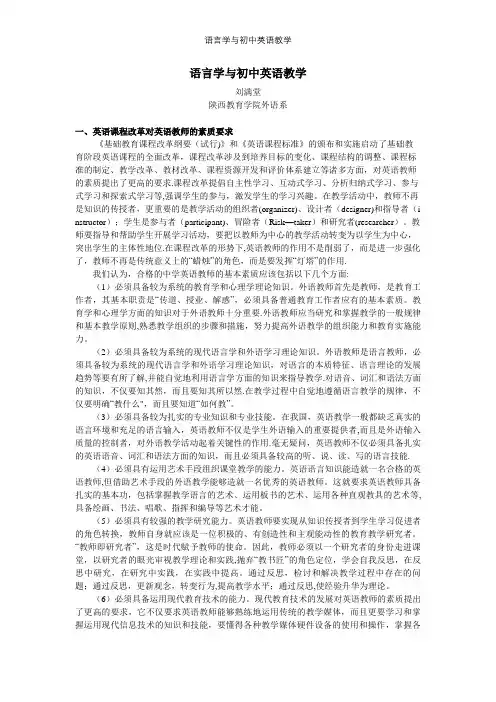
语言学与初中英语教学刘满堂陕西教育学院外语系一、英语课程改革对英语教师的素质要求《基础教育课程改革纲要(试行)》和《英语课程标准》的颁布和实施启动了基础教育阶段英语课程的全面改革,课程改革涉及到培养目标的变化、课程结构的调整、课程标准的制定、教学改革、教材改革、课程资源开发和评价体系建立等诸多方面,对英语教师的素质提出了更高的要求.课程改革提倡自主性学习、互动式学习、分析归纳式学习、参与式学习和探索式学习等,强调学生的参与,激发学生的学习兴趣。
在教学活动中,教师不再是知识的传授者,更重要的是教学活动的组织者(organizer)、设计者(designer)和指导者(i nstructor);学生是参与者(participant)、冒险者(Risk—taker)和研究者(researcher)。
教师要指导和帮助学生开展学习活动,要把以教师为中心的教学活动转变为以学生为中心,突出学生的主体性地位.在课程改革的形势下,英语教师的作用不是削弱了,而是进一步强化了,教师不再是传统意义上的“蜡烛”的角色,而是要发挥“灯塔”的作用.我们认为,合格的中学英语教师的基本素质应该包括以下几个方面:(1)必须具备较为系统的教育学和心理学理论知识。
外语教师首先是教师,是教育工作者,其基本职责是“传道、授业、解惑”,必须具备普通教育工作者应有的基本素质。
教育学和心理学方面的知识对于外语教师十分重要.外语教师应当研究和掌握教学的一般规律和基本教学原则,熟悉教学组织的步骤和措施,努力提高外语教学的组织能力和教育实施能力。
(2)必须具备较为系统的现代语言学和外语学习理论知识。
外语教师是语言教师,必须具备较为系统的现代语言学和外语学习理论知识,对语言的本质特征、语言理论的发展趋势等要有所了解,并能自觉地利用语言学方面的知识来指导教学.对语音、词汇和语法方面的知识,不仅要知其然,而且要知其所以然.在教学过程中自觉地遵循语言教学的规律,不仅要明确“教什么",而且要知道“如何教”。
语言学在英语教学中的应用
语言学在英语教学中的应用
英语教学需要充分运用各门学科的知识,其中语言学的知识是比较重要的一种知识,
它为教学活动和研究提供了重要的技术指导。
从语言学的理论出发,语言学在英语教学中
有着全面的应用。
首先,语言学概念及相关理论可以支撑英语教育的一系列话题,包括书面语言教育,
口语教育,听力教育以及英语词汇教育。
其次,语言学在教学中也能够有效地帮助老师提
出具体的课程内容,教材资料,教学方法和评价等环节,这些活动均受到语言学的强有力
的支持。
第三,语言学教学法可以更好地支持英语教学的发展,有关英语的发音、语法、搭配
习惯等等均可以借助于语言学的理论与方法来加以引导,以进一步提升英语语言教学水平。
最后,语言学在语言教学中还有一个重要功能,那就是语言学知识可以有效地促进学
生们综合运用他们学习到的知识,协助学生更加理解语言,把语言学习变成一种更有意义
的体验,以增加学生的学习兴趣,提高学习效率。
总之,语言学知识是英语语言学习的重要基础,它可以为英语教学提供有力的技术支持,助学生们更好地深入理解语言,有利于更快地提高英语水平。
因此,英语教师应该熟
悉语言学和语言学理论,从而更好地把语言学知识融入教学过程当中。
英语教学中应用语言学的有效应用摘要:当代教育教学发展的过程当中,应用语言学可以说是其中一门非常重要的学科,并且与语言学密切相关,可以说,应用语言学与英语教学间有着互相融合的意义,这些年,我国教育专家也开始加深了对应用语言学的不断研究与探索。
到目前为止,应用语言学与英语教学在英语教育方面发挥了非常重要的作用。
接下来,本篇文章围绕英语教学中应用语言学的有效应用开展论述,望能够对大家具有一定的参考借鉴价值。
关键词:英语教学;应用语言学;应用1应用语言学的研究1.1语言教学领域据相关资料调查可以了解到:英语教学中应用语言学发挥着至关重要的作用。
应用语言学是确保教学质量、教学效率的基础性条件,作用是非常大的。
在这种教育教学环境下,应用语言学和英语教学之间有着很大的不同,但是,依然有少部分的应用语言学家对语言学并没有深入地了解。
怎样做到合理的综合现有知识来进行英语教学模式的不断创新是当下应用语言学家高度关注的焦点,也是推动我国语言教学进步的重要因素。
1.2语言政策与计划领域伴随着时间的不断推移,各教育研发机构也开始慢慢地认识到政治独立、少数民族暴动等对社会语言学、心理学之间所存在的紧密联系,对此,应当用发展的眼光来看待问题、分析问题。
根据调查我们可以了解到:英语可以说是一门有着巨大社会经济价值的国际语言,开展英语应用语言教学可以说具有非同寻常的重要意义。
1.3语言通讯领域在社会快速发展的今天,人们也开始慢慢地明白:通讯技术的发展与语言学之间所存在的密切关联,譬如,英国机器翻译研究人员在相关研究工作开展过程当中,无法避免的会有一定情况下语言问题的存在,同时要与有关方面的语言专家来做出解答。
此外,电话通讯工程师在对“怎样能够促使一条电话线包含更多的对话”这一主题的过程当中,其实也与语言学家的帮助与支持离不开,语言学家在一定程度上帮助通讯工程师来更好地掌握电子工程以及信息理论的基础上,来掌握更多的语言发音技巧、声学知识等等。
语言学在英语教学中起到了重要的作用,主要体现在以下几个方面:
1. 语言知识的基础:语言学研究了语言的结构、规则和功能等,为英语教学提供了深入的理论基础。
通过语言学的知识,教师可以更好地理解英语的语法、词汇和语音规则,有助于教师在教学中准确传授语言知识。
2. 词汇和语法教学:语言学帮助教师了解词汇的构成和运用规则,以及句子结构和语法规则。
教师可以利用语言学的知识,帮助学生掌握和运用词汇和语法,提高英语的语言表达能力。
3. 语音和发音教学:语言学研究语音和发音规则,帮助教师了解不同语音和音标的发音方法。
通过语言学的知识,教师可以引导学生正确发音和模仿语音,提高学生的口语能力。
4. 语用和交际教学:语言学不仅研究语言结构,还研究语言的使用和交际功能。
在英语教学中,语用和交际教学帮助学生理解语言的意义和使用情境,并培养他们在真实语境中运用英语进行交流的能力。
5. 语篇解读和阅读理解:语言学对语篇的结构和逻辑关系进行研究,教师可以运用语言学的方法,帮助学生理解英语的文章和阅读材料,提高阅读理解能力。
总之,语言学为英语教学提供了方法和理论基础,它帮助教师更好地理解和教导语言知识,同时也帮助学生更好地掌握和应用英语语言技能,从而提高他们的语言能力和语言意识。
语言学在中学英语教育中的应用导言:语言学作为一门研究语言现象的学科,对于中学英语教育的实施具有重要的指导意义。
本文将从语言的结构、语言的习得以及语言的教学三个方面,探讨语言学在中学英语教育中的应用。
一、语言的结构语言的结构是语言学研究的重要内容之一。
而在中学英语教育中,了解语言的结构对于学生的语言习得和应用具有重要作用。
首先,语法是语言结构的核心。
在中学英语教育中,学生需要掌握语法的基本概念和规则,比如主谓一致、时态、语态等。
通过对语法的学习,学生可以更好地理解和运用英语句子的结构,从而提高他们的语言表达能力。
其次,词汇是语言的基本元素。
掌握丰富的词汇量是学生英语学习的关键之一。
通过语言学对词汇的分类和研究,中学教师可以帮助学生系统地学习和记忆词汇。
同时,了解词汇的词义变化和词汇搭配规律,有助于学生正确理解和运用各类词汇。
此外,音韵学也是语言学的一个重要分支。
在中学英语教育中,学生需要掌握英语的音节、音标等基本知识,从而提高他们的英语发音和听力能力。
了解音韵学的基本原理和规律,对于学生的英语学习具有重要的帮助。
二、语言的习得语言的习得是指学习者在接触和使用语言的过程中,逐渐熟练掌握和使用语言的各种能力。
语言学在中学英语教育中对语言的习得具有重要的启示作用。
首先,语言学对语言的习得过程进行了科学的描述和分析。
根据语言学的研究成果,我们了解到语言习得是一个渐进的过程,需要通过接触语言、输入与输出、反馈和积累等环节。
中学教师可以根据这些原理,设计合理的教学活动,帮助学生逐步提高他们的语言能力。
其次,语言学在中学英语教育中强调了语言的功能性。
根据语言学的研究,语言学习者更关注语言的应用能力,而非纯粹的语法和词汇知识。
在中学英语教育中,教师可以通过一些真实的语言情境和交际活动,激发学生的语言运用能力,并提高他们的听说读写技能。
此外,语言学还对语言习得的影响因素进行了深入探讨。
语言学认为,学习者的个人因素、社会文化背景以及学习环境都会影响到语言的习得。
试述英语教学中应用语言学的有效应用1 语言学在英语教学中的应用在英语教学中,语言学是一个重要的理论,它有助于帮助学习者提高对英语的理解和使用能力。
语言学的有效应用,可以帮助学习者在深入探究英语的结构、语法和言语表现力等内容方面具有良好的基础,从而在实际的语言表达活动中获得良好的理解和表达能力。
2 语言学的基本原理语言学是一门研究语言运行机理的学科,它基于对语言文字、语音、语义等各种要素的研究,运用系统分析的方法,在英语教学中提供了一项指导。
语言学指出,语言系统是按照自然规律发展的,每一个语言都对应到一系列语言学规律;也就是说,每一种语言都有其特定的语言结构、语法、词汇以及表达方式等特征,具有明确的规则。
3 语言学在英语教学中的应用语言学在英语教学中的应用主要有两个层面。
一是教学层面。
语言学能够帮助教师和学习者掌握英语的规律,对学习者及时正确的指导及自我检查;另一个层面是语言学与学习者的互动性。
学习者可以借助语言学方法,学会用英语表达语法和词汇,理解不同层次的英语语义,运用习惯用法,从而获得较高水平的英语能力。
4 语言学在英语教学中的优势语言学在英语教学中,主要优势可以归结为以下三点:(1)科学合理。
通过语言学的研究,可以帮助学习者掌握英语的规律性,并系统的掌握英语的语言结构和技巧,便于学习者正确使用英语。
(2)实践性强。
语言学把实践作为其主要核心,将语言学知识与实践紧密结合起来,具有很强的实践性,可以更好地指导学习者正确使用英语。
(3)良好认知效果。
由于语言学知识跟英语学习者的实际认知和掌握情况紧密结合在一起,在提高学习者的英语表达能力的同时,也可以提高学习者的认知能力。
5 总结语言学作为一门极富指导意义的学科,在英语教学中具有重要的作用,它可以帮助学习者建立起深入理解语言的基础,掌握规律性,学会灵活运用英语,有助于掌握英语的结构、语法和言语表现力等内容,从而在实际的语言表达活动中获得良好的理解和表达能力。
应用语言学理论指导下大学英语教学与实践作者:崔童张春平来源:《科教导刊·电子版》2013年第10期摘要随着社会发展的需要,应用语言学理论不断得到完善,其在语言生活实践中发挥出了越来越重要的作用,如何将应用语言学理论应用到大学英语教学实践中,摸索出适合中国大学生学习英语的教学方法,使学生们能更高效的学习英语,成了摆在广大大学英语教师面前的新课题。
关键词应用语言学教学法英语教学中图分类号:G424 文献标识码:A应用语言学是一门新兴学科,发展至今已经有50年的光辉历程,它的研究面广,涉及的问题多。
应用语言学是社会发展的需要,语言生活实践是应用语言学理论最根本的最终来源。
应用语言学特别强调所使用的方法要受到实践的检验,常常要一边解决实际问题一边建立和完善应用语言学理论。
1 语言教学的发展历程语言教学是应用语言学的主要内容。
在应用语言学理论的不断发展过程中,也催生了各种与其理论相匹配的教学方法。
最早的结构主义语言学就把语言看作是刺激反应的结果。
在语言教学理论中,强调语言学习的过程是一种刺激反应的过程,要学会一种语言,必须进行强化刺激、反复刺激,才能产生深刻反应,达到记住并运用的行为,这就是听说法的由来。
交际教学法的核心认为语言首先是一种社会交际的工具,因而主张以具体的交际功能项目如问候、邀请、做客、看病等主要线索来安排教学内容,并根据学生将来工作的实际需要来确定其培养目标的侧重面,加强针对性。
它认为学习外语不能脱离使用外语的情景,外语教学主要不是讲解语言规则和机械地操练句型,而是在真实的情景中恰当地使用真实的语言,教师在课堂上设立交际情景,学生是交际者,教师发起学生间的各种活动,有时自己也参与进去,而学生间的活动是大量的。
交际教学法强调教学过程中的交际化,以话语为教学单位,教师在体现交际情景的话语中综合运用语音、词汇、语法、句型等知识,来培养学生的交际能力,同时将培养语言交际能力作为语言教学的出发点和归宿。
思考题
一、判断
1.Teaching cannot be defined apart from learning.
2. Teaching problems are simply learning problems.
3. According to The tabula-rasa or“blank-slate”view, humans have few if any natural predispositions. Development is dependent upon the individual’s experiences.
4. According to Chomsky, the child learns his first language by imitation.
5. The concept of L2 (second language, foreign language and non-native language) implies that the individual is already in command of an L1.
6. There are individual differences for different learners, different types of learning tasks, different strategies and styles. (p.77)
7. Comprehension is the highest level of understanding.
8. Evidence shows that attitudes are accompanied by positive and negative feelings
9. Self-actualization refers to the desire to fulfill one’s self-esteem.
10. Culture is a set of shared ideals, values and standards of behavior
11. Language, thought and culture can be dealt with separately.
12. Culture shock has generally been considered as having a negative effect on L2 learning.
13. Theoretical contrastive studies do not belong to comparative descriptive linguistics.
14. Empirical evidence has shown that intralingual errors only constitute a small proportion of L2 learners’errors, and that among other factors, interlingual effects of learning play an important role.
15. Test is not an end in itself.
二、选择题
1.The learner has an even greater role to play in the ______ process.
A. teaching
B. learning
C. teaching-learning
2. Learning is _____ dependent upon environment.
A. completely
B. partly
C. unnecessarily
3. According to Chomsky, the child learns his first language by______.
A. imitation
B. creative hypothesis-testing
C. hypothesis-testing
4. Attitude is generally agreed to show three aspects: ___ ___ and ___.
A. cognitive, affective, behavioral
B. mental, affective, behavioral
C. mental, personal, cognitive
5. According to Maslow, the high level needs of self-actualization are growth needs, whereas those below are ______.
A. deficiency needs
B. incomplete needs
C. fundamental needs
6. Haviland (1975) summarizes four universal characteristics of culture: Culture is shared, based on symbols, integrated, and ______.
A. inherited
B. learned
C. developed
7. Interlanguage refers to “the _____ meaningful performance”in a second language.
A. limited
B. learned
C. attempted
8. Errors made by L2 learners can be observed, analyzed, classified, and ______.
A. expected
B. described
C. corrected
9. Error analysis generally consists of three stages, namely, identification, _____ and explanation.
A. correction
B. expectation
C. description
10. A good test must meet four requirements: _____, reliability, discrimination and practicality.
A. validity
B. responsibility
C. facility
11. The TOEFL is a kind of ______.
A. Aptitude tests
B. Criterion-referenced tests
C. Diagnostic tests
12. According to Dulay et al. (1982), there are three kinds of motivation affecting language acquisition: Integrative motivation, _____ and Social-group-identification motivation.
A. Instrumental motivation
B. Practical motivation
C. Creative motivation
13. Stern (1983) identifies four basic sets of strategies from the basic considerations and research of language learning. These strategies are: Active planning strategy, Academic learning strategy, Social learning strategy, and _____ strategy.
A. Practical
B. Creative
C. Affective
14. As to how to correct errors, it requires a combination of _____, cognitive and linguistic judgment.
A. objective
B. subjective
C. affective
15. There are three methods to describe tests: central tendency, _______ and percentile rank.
A. dispersion of scores
B. standard deviation
C. variance
答案:
一、判断题
1.T
2. F
3. T
4. F
5. T
6. T
7.F
8.T
9.F 10.T 11.F 12.T 13.F 14.F 15.T
二、选择题
1.C
2. A
3.B
4. A
5.A
6. B
7. C
8. B
9. C 10.A 11.B 12.A 13. C 14.
C 15.A。